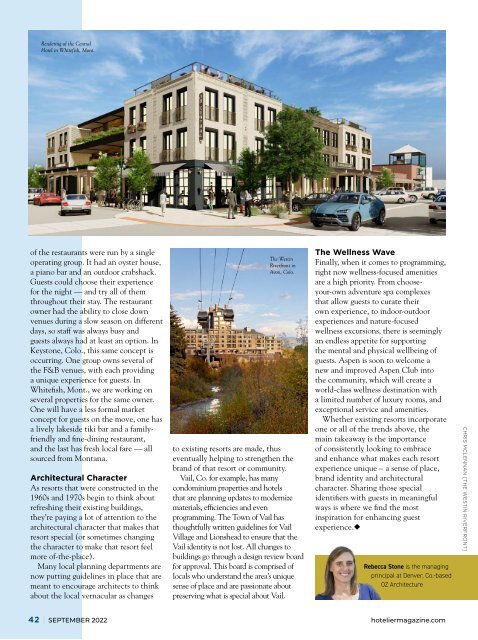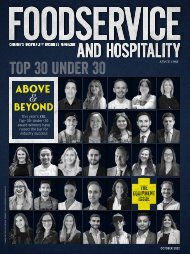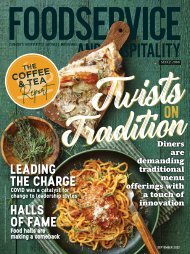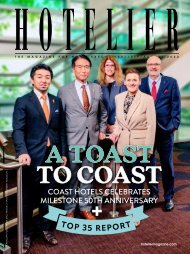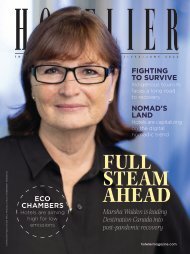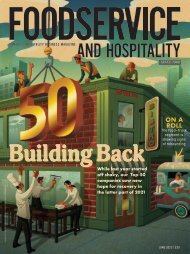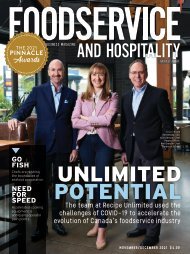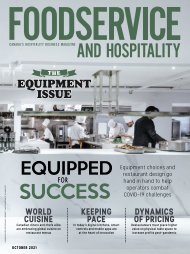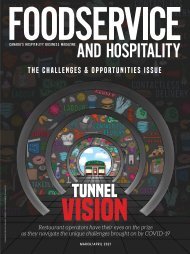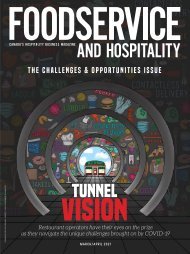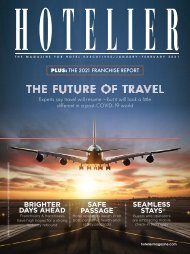September 2022 Digital Issue
You also want an ePaper? Increase the reach of your titles
YUMPU automatically turns print PDFs into web optimized ePapers that Google loves.
Rendering of the Central<br />
Hotel in Whitefish, Mont.<br />
F&B<br />
HOTELS ARE REBOUNDING AFTER BREAKFAST WAS TOAST<br />
of the restaurants were run by a single<br />
operating group. It had an oyster house,<br />
a piano bar and an outdoor crabshack.<br />
Guests could choose their experience<br />
for the night — and try all of them<br />
throughout their stay. The restaurant<br />
owner had the ability to close down<br />
venues during a slow season on different<br />
days, so staff was always busy and<br />
guests always had at least an option. In<br />
Keystone, Colo., this same concept is<br />
occurring. One group owns several of<br />
the F&B venues, with each providing<br />
a unique experience for guests. In<br />
Whitefish, Mont., we are working on<br />
several properties for the same owner.<br />
One will have a less formal market<br />
concept for guests on the move, one has<br />
a lively lakeside tiki bar and a familyfriendly<br />
and fine-dining restaurant,<br />
and the last has fresh local fare — all<br />
sourced from Montana.<br />
Architectural Character<br />
As resorts that were constructed in the<br />
1960s and 1970s begin to think about<br />
refreshing their existing buildings,<br />
they’re paying a lot of attention to the<br />
architectural character that makes that<br />
resort special (or sometimes changing<br />
the character to make that resort feel<br />
more of-the-place).<br />
Many local planning departments are<br />
now putting guidelines in place that are<br />
meant to encourage architects to think<br />
about the local vernacular as changes<br />
The Westin<br />
Riverfront in<br />
Avon, Colo.<br />
to existing resorts are made, thus<br />
eventually helping to strengthen the<br />
brand of that resort or community.<br />
Vail, Co. for example, has many<br />
condominium properties and hotels<br />
that are planning updates to modernize<br />
materials, efficiencies and even<br />
programming. The Town of Vail has<br />
thoughtfully written guidelines for Vail<br />
Village and Lionshead to ensure that the<br />
Vail identity is not lost. All changes to<br />
buildings go through a design review board<br />
for approval. This board is comprised of<br />
locals who understand the area’s unique<br />
sense of place and are passionate about<br />
preserving what is special about Vail.<br />
The Wellness Wave<br />
Finally, when it comes to programming,<br />
right now wellness-focused amenities<br />
are a high priority. From chooseyour-own<br />
adventure spa complexes<br />
that allow guests to curate their<br />
own experience, to indoor-outdoor<br />
experiences and nature-focused<br />
wellness excursions, there is seemingly<br />
an endless appetite for supporting<br />
the mental and physical wellbeing of<br />
guests. Aspen is soon to welcome a<br />
new and improved Aspen Club into<br />
the community, which will create a<br />
world-class wellness destination with<br />
a limited number of luxury rooms, and<br />
exceptional service and amenities.<br />
Whether existing resorts incorporate<br />
one or all of the trends above, the<br />
main takeaway is the importance<br />
of consistently looking to embrace<br />
and enhance what makes each resort<br />
experience unique – a sense of place,<br />
brand identity and architectural<br />
character. Sharing those special<br />
identifiers with guests in meaningful<br />
ways is where we find the most<br />
inspiration for enhancing guest<br />
experience.◆<br />
Rebecca Stone is the managing<br />
principal at Denver, Co.-based<br />
OZ Architecture<br />
CHRIS MCLENNAN [THE WESTIN RIVERFRONT]<br />
BY ROBIN ROBERTS<br />
IT<br />
may be the most important<br />
meal of the day, but at the<br />
height of the pandemic,<br />
hotel breakfast was not<br />
all it was cracked<br />
up to be. Guests<br />
woke up not to the<br />
tantalizing smell<br />
of sizzling bacon at a vast, bustling buffet,<br />
but to a cold, pre-packaged muffin. Or<br />
nothing at all. Scrambling to comply<br />
with a rash of regulations, some hotels<br />
packed up the chafing dishes and<br />
prepared only âầla carte served strictly<br />
by staff — hands off the tongs, please.<br />
Others plastic-wrapped their meagre<br />
offerings within an inch of their life.<br />
Some didn’t even brew coffee, so as to<br />
eliminate e and crowding. Breakfast, for<br />
a time, was toast.<br />
SO LONG, SUMPTUOUS SPREADS<br />
(FOR SOME)<br />
Prior to the pandemic, many hotels felt they<br />
had to keep up with the competition by beefing<br />
up their breakfasts, adding omelette bars, pancake<br />
and waffle stations, fresh-baked cinnamon rolls, as<br />
well as healthier options such as smoothies, Greek<br />
yogurt, fresh fruit, oatmeal and avocado toast. Some<br />
properties topped out at 40 items, straining the foodand-beverage<br />
budget, not to mention grappling with<br />
the resulting waste of all that leftover food.<br />
“The cook-to-order breakfast buffet is the brand<br />
standard for Hilton Garden Inn,” says Perry Singh,<br />
general manager of Hilton Garden Inn Saskatoon.<br />
“So, you had to have the buffet, all the self-service<br />
42 | SEPTEMBER <strong>2022</strong><br />
hoteliermagazine.com hoteliermagazine.com SEPTEMBER <strong>2022</strong> | 43


